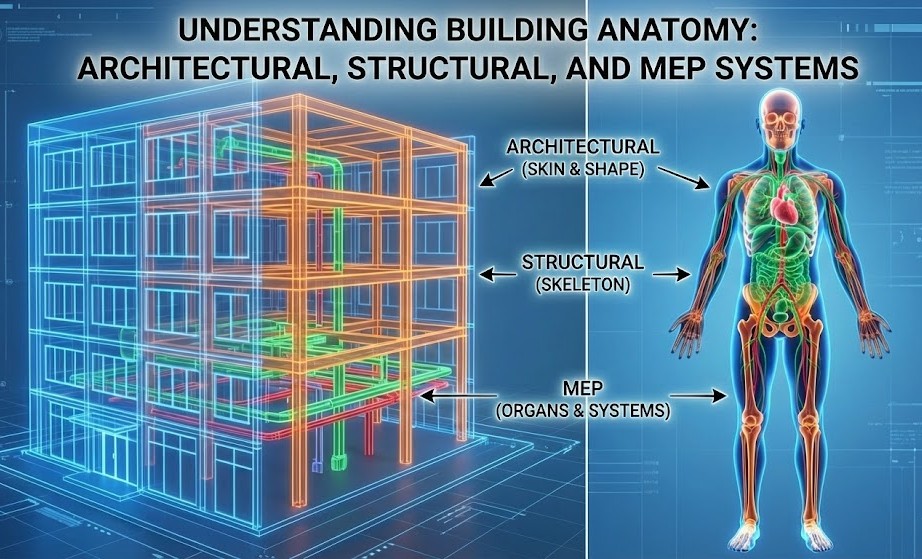
Author: Devika R
January 1, 2024
3 min read
In the world of construction, using Building Information Modeling (BIM) has changed how projects are done. BIM helps with designing, building, and managing projects. To make BIM work well, everyone needs to follow certain rules called standards. These standards help different people involved in a project to work together smoothly and share information easily. This is important for the success of the whole project.
The Essence of BIM Standards:

Think of BIM standards as a common language for everyone in construction to understand. These standards are like rules made by construction experts that guide how we create, share, and manage digital information in BIM (Building Information Modeling). When people in construction follow these standards, like architects, engineers, builders, and facility managers, they can all work together smoothly on the same digital platform.
Several types of Building Information Modeling (BIM) standards provide guidelines and specifications for different aspects of the construction and building information processes. Here are some key types of BIM standards:
Data Exchange Standards:
- IFC (Industry Foundation Classes): A standardized file format for the exchange of BIM data across different software platforms.
- COBie (Construction Operations Building Information Exchange): A standard for organizing and delivering facility information.
Modeling Standards:
- LOD (Level of Development): Defines the level of detail and accuracy of information in BIM models at different stages of a project.
- BSI PAS 1192-2: British standard outlining the processes for the production, management, and exchange of information.
Classification Standards:
- Uniclass: A classification system for organizing information in construction projects.
- OmniClass: A system for classifying and organizing information throughout the life cycle of a facility.
Naming and File Organization Standards:
- ISO 19650: International standard for managing information about buildings throughout their life cycle, including recommendations for naming conventions and file organization.
Geospatial Standards:
- LandXML: A standard for the exchange of civil engineering design data between different software applications.
- CityGML: A standard for the representation and exchange of 3D city models.
COBie Standards:
- COBieUK: An extension of COBie specific to the United Kingdom, providing additional guidelines for information exchange.
Industry-Specific Standards:
- AIA E202: Developed by the American Institute of Architects, providing digital data protocol for BIM.
- VICO (Virtual Construction Management Guide): Developed by the BuildingSMART Alliance, offering guidelines for construction project management using BIM.
Energy Analysis Standards:
- gbXML (Green Building XML): A schema for transferring building information into energy analysis tools.
Smoother Collaboration Across Disciplines:

Using the same BIM standards helps different experts work together better. It’s like everyone speaking the same language. When architects follow the rules and create designs, they can easily share them with structural engineers. The engineers can then add their analysis without any problems. This teamwork makes sure that everyone’s knowledge adds up perfectly for the whole project.
Making Data Sharing Easier:

Imagine if different computer programs could talk to each other easily—that’s what we mean by interoperability in BIM. It’s like having a superpower that lets information move smoothly between different software. When we stick to standards, it means the cool designs we make in one computer program can be easily used in another one, without losing any details or functions. This is super important because we use different software for different parts of building projects, like designing, estimating costs, and managing the building after it’s done.
Saving Time and Money:

Following the rules of BIM standards doesn’t just make things easier—it also saves a lot of time and money. When everyone involved in a project follows the same standards, we don’t have to spend a ton of time changing information from one format to another. This speeds up the project and makes it less likely for mistakes to happen when we’re moving information around. So, in the end, projects get done faster, within budget, and with fewer mistakes.
Getting Ready for the Future:
Imagine the construction industry like a big puzzle. As new technology keeps coming in, BIM standards act like the puzzle pieces that help fit everything together. These standards make sure that new tools and cool tech things, like artificial intelligence and machine learning, can easily become part of how we build things. It’s like having a flexible base that can welcome all the latest innovations without needing a big change in how we do things.
To sum it up, BIM standards and interoperability are like the building blocks for a digital world in construction. They set the stage for teamwork, sharing information, and making sure projects turn out great. As the construction world keeps moving towards more digital stuff, sticking to BIM standards is super important. It’s like paving the road for a future where everyone works together, shares ideas, and uses the coolest technology to build amazing things.





